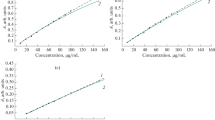Abstract
In different parts of both micropropagated and intact(ordinary, soil-grown) chamomile plants and in hairyroot cultures of this species, formaldehyde (HCHO) indimedone adduct form was identified and quantified byan automatic OPLC instrument using authenticformaldemethone as a standard. The amount of HCHObound by the dimedone reagent increases as theconcentration of dimedone is increased, until amaximum is reached. The HCHO detected is thought to bederived from metabolically-labile hydroxymethylgroups, and suggests that some as yet unidentifiedhydroxymethyl-containing molecule in chamomile mayplay an important role in the metabolism of this commonmedicinal plant.
Similar content being viewed by others
References
Aggag ME and Yousef RT (1972) Study of antimicrobial activity of chamomile tea. Planta Med 21: 140-144
Bayer I, Katona K and Tardos L (1958) Adatok a Chamomillae flos cholin-tartalmához (Data to the choline content of Chamomillae flos). Acta Pharm Hung 28: 164-167
Carle R and Isaac O (1985) Fortschritte in der Kamillenforschung in der Jahren 1974 bis 1984. Dtsch Apoth Z 125 Suppl 1: 2-8
Ferenczi-Fodor K, Minosovics E and Tyihák E (1991) Over-pressured layer chromatography. In: Sherma J and Fried B (eds) Handbook of Thin-Layer Chromatography 55. New York: Marcel Dekker Inc, pp 155-181
Gerritsen ME, Carley WW, Ranges GE, Shen Ch-P, Phan SA, Ligon GF and Perry CA (1995) Flavonoids inhibit cytokineinduced endothelial cell adhesion protein gene expression. Am J Pathol 147: 278-292
Heck H.d'A, Casanova M and Starr TB (1990) Formaldehyde toxicity-new understanding. Crit Rev Toxicol 20: 397-426
Huszti Z and Tyihák E (1986) Formation of formaldehyde from S-adenosyl-L-(methyl-3H) methionine during enzymatic transmethylation of histamine. FEBS Letters 209: 362-366
Karrer W, Cherbuliez E and Eugster CH (1977) Konstitution und Vorkommen der organischen Pflanzenstoffe (exclusive Alkaloide). Birkhäuser Verlag Basel und Stuttgart
Kedderis GL and Hollenberg PF (1983) Peroxidase-catalysed N-demethylation reactions. J Biol Chem 259: 663-668
László I, Szöke É and Tyihák E (1998) Relationship between abiotic stress and formaldehyde concentration in tissue culture of Datura innoxia Mill. Plant Growth Regul 25: 195-199
Li B, Robinson DH and Birt DF (1997) Evaluation of properties of apigenin and [G-3H] apigenin and analytical method development. J Pharm Sci 86: 721-725
Máday E and Szöke É (1996) Production of essential oil in chamomile tissue cultures. Proceedings of International Conference Tarcal-Tokaj (edited by Terpó A. and Mochnackì S.) Gödöllö, pp 177-184
Máday E., Szöke É., Lemberkovics É and Muskáth Zs. (1999) The study of the production of essential oils in chamomile hairy root cultures. Eur J Drug Metab Pharmacokinet, in press
Reichling J, Becker H, Exner J and Dräger PD (1979) Vergleichende Untersuchungen verschiedener Handelsmuster von Matricariae flos. Pharm Z 124: 1998-2005
Reichling J, Bisson W, Becker H and Schilling G (1983) Zusammensetzung und Akkumulation des ätherischen Öls in Matricariae Radix 2. Mitt Z Naturforsh 38c: 159-161
Sárdi É and Tyihák E (1998) Relationship between dimedone concentration and formaldehyde captured in plant tissues. Acta Biol Hung (In press)
Schilcher H (1987) Die Kamille. Wiss Verlagsges, Stuttgart
Szöke É, Shavarda A and Kuzovkina IN (1979) Effect of the culturing conditions on essential oil formation in callus tissue of wild chamomile inflorescences. Sov Plant Physiology 25: 579-584
Tubaro A, Zilli C, Redaelli C and Della Loggia R (1984) Evaluation of anti-inflammatory activity of a chamomile extract after topical application. Planta Med 50: 359
Tyihák E, Blunden G, Yang M, Crabb TA and Sárdi É (1996) Formaldehyde, as its dimedone adduct, from Ascophyllum nodosum. J Appl Phycol 8: 211-215
Tyihák E, Rozsnyai Z, Sárdi É and Szöke É (1992) Formaldehyde cycle and the cell proliferation: Plant tissue as a model. In: Tyihák E (ed) Proc 3rd Intern Conf on Role of Formaldehyde in Biological Systems. Sopron Hungary: Biochem Soc Budapest, pp 139-144
Author information
Authors and Affiliations
Rights and permissions
About this article
Cite this article
Máday, E., Tyihák, E. & Szöke, É. Occurrence of formaldehyde in intact plants, micropropagated plants and hairy root cultures of chamomile (Matricaria recutita L.). Plant Growth Regulation 30, 105–110 (2000). https://doi.org/10.1023/A:1006320905207
Issue Date:
DOI: https://doi.org/10.1023/A:1006320905207




